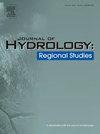Estimating the groundwater table threshold for mitigating soil salinization in the Songnen Plain of China
IF 4.7
2区 地球科学
Q1 WATER RESOURCES
引用次数: 0
Abstract
Study region
The Songnen Plain is a key part of China’s largest plain, situated in northeastern China.
Study focus
Soil salinization has become one of the largest ecological issues in the Songnen Plain, and regulating groundwater levels is a crucial strategy for mitigating it. To address this, a comprehensive framework is developed to estimate the groundwater table threshold for soil salinization by integrating field sampling, remote sensing big data, and machine learning models.
New hydrological insights for the region
The soil salinity inversion model, which utilizes a random forest algorithm, achieves the highest accuracy (R2 = 0.75, d = 0.94, RPD = 2.05), outperforming SVM, LightGBM, and XGBoost algorithms. From 2020–2023, areas with mild salinization accounted for 9.3 % of the total area, while moderate salinization accounted for 3.2 %, severe salinization accounted for 4.0 %, and saline soil areas accounted for 0.6 %. A probabilistic model further identifies groundwater depth thresholds for salinization: 2.3 m for sandy soil, 3.1 m for loamy soil, and 1.1 m for silty soil. Based on current groundwater depths, it is anticipated that 15.5 % of the Songnen Plain area will continue to be affected by soil salinization or remain at risk of potential salinization.
求助全文
约1分钟内获得全文
求助全文
来源期刊

Journal of Hydrology-Regional Studies
Earth and Planetary Sciences-Earth and Planetary Sciences (miscellaneous)
CiteScore
6.70
自引率
8.50%
发文量
284
审稿时长
60 days
期刊介绍:
Journal of Hydrology: Regional Studies publishes original research papers enhancing the science of hydrology and aiming at region-specific problems, past and future conditions, analysis, review and solutions. The journal particularly welcomes research papers that deliver new insights into region-specific hydrological processes and responses to changing conditions, as well as contributions that incorporate interdisciplinarity and translational science.
 求助内容:
求助内容: 应助结果提醒方式:
应助结果提醒方式:


